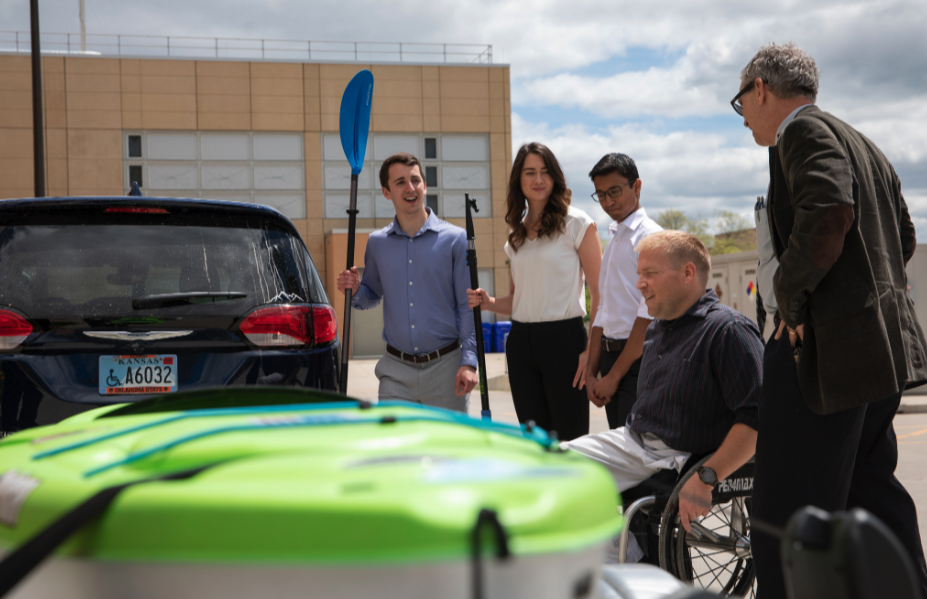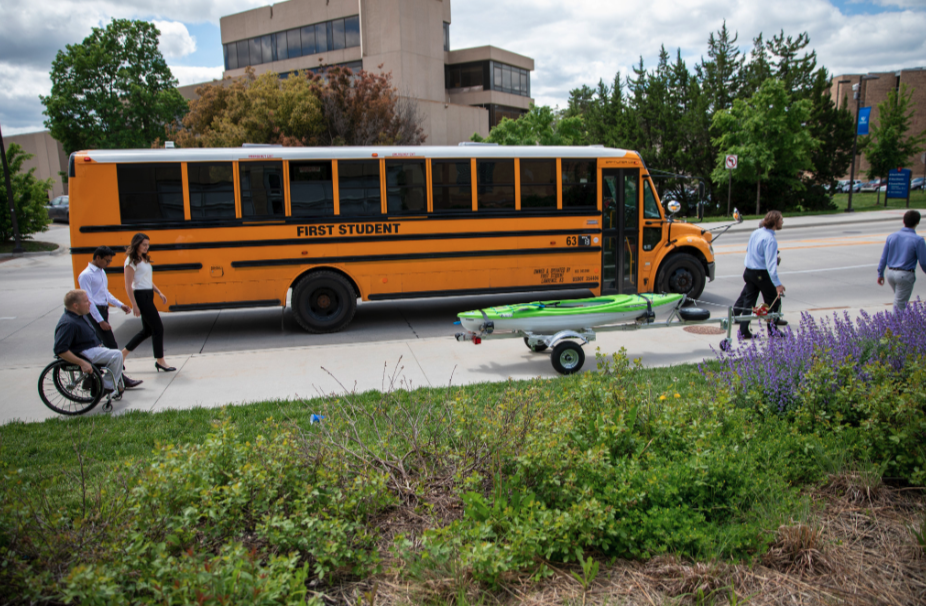Engineering students design adaptation to help KC kayaker who uses wheelchair

LAWRENCE — There are few things that David Hosch loves more than getting in his kayak and getting out on the water. But getting his kayak to the water hasn’t always been easy for the 36-year-old Olathe resident.
Hosch uses a wheelchair, the result of an accident when he was young. "I was injured when I was 6,” he said. “I was riding my bike. I was run over by a delivery truck. It crushed my pelvis, and that did all sorts of damage. The doctors had to amputate my left leg." His right leg was also badly injured in the accident.
For much of his life, then, the decision to go kayaking has been more complicated than he would like.
"Using a normal kayak is easy for me,” he said. “The harder thing is transporting it. I'd have to climb on top of my van and strap it down up there. Getting it to a lake or a river, getting it from the car to the water, those were the biggest impediments to me being able to kayak on my own."
Thanks to a group of students in the School of Engineering at the University of Kansas, Hosch no longer has to worry about being independent when he wants to get on the water. Those students designed and built a special adaptation to a trailer that lets Hosch load and unload his kayak on his own.
“I can't express enough how awesome it is,” Hosch said.
The process started in the summer of 2018, when Hosch — searching for a solution to his problem — contacted the School of Engineering. “I cast a line out,” he said. “I didn't know if anything was going to come of it."
 As it happened, KU had for several years run what it called the “BREAK Program” — the acronym for Biomechanical Rehabilitation Engineering Advancement in Kansas — which had been funded through a grant from the National Science Foundation to provide customized design services to individuals with disabilities and was overseen by Ken Fischer, director of KU’s Bioengineering Program. Through that program, KU connected Hosch to a student team who took on the project as part of their capstone project, in which seniors in the engineering school participate in a design-build project to complete their degree requirements.
As it happened, KU had for several years run what it called the “BREAK Program” — the acronym for Biomechanical Rehabilitation Engineering Advancement in Kansas — which had been funded through a grant from the National Science Foundation to provide customized design services to individuals with disabilities and was overseen by Ken Fischer, director of KU’s Bioengineering Program. Through that program, KU connected Hosch to a student team who took on the project as part of their capstone project, in which seniors in the engineering school participate in a design-build project to complete their degree requirements.
"Those kids took the lead,” Hosch said.
"We started with sitting down and talking with David about what he was looking for, why he wanted this,” said Luke Lindemann, a 2019 graduate in mechanical engineering from Andover who helped lead the team. “At first it wasn't a kayak trailer — at first it was just about going kayaking on his own without any outside help. He wanted the freedom of going on his own. It was pretty evident that David enjoys the freedom kayaking brings him. We wanted to make this dream of his come true."
Getting from that hope of freedom to the end product took time. Lindemann’s team visited with Hosch and spent time watching as he went kayaking.
"We went to the lake a few times and saw his current process,” Lindemann said. Hosch, he said, would have somebody strap the kayak to the top of his van. Once at the lake, Hosch would crawl out the car window, undo the straps holding the kayak and push the craft to the ground.
After watching Hosch’s process, the KU students brainstormed ideas. They considered several alternatives — including a foldable kayak and a Go Kart-style amphibious kayak — before settling on a trailer as the most efficient answer.
"We wanted to do the most cost-efficient, most time-efficient and most reliable way to get him in the water,” Lindemann said. “Most of the other ideas, we needed a trailer anyway."
The group found and purchased an aluminum trailer online, then modified it to assist Hosch, adding a winch and a special tie-down system that is easy for Hosch to use. Now when Hosch goes to the lake, he backs the trailer up to the water, slides the kayak off and is ready to go.
"It's definitely a learning process. But it works really well,” Hosch said. “I was able to get the kayak out on the water — it worked wonderfully.”
“I wanted to have the chance to wake up on a Saturday morning and say, 'I think I'm going kayaking today,'” he said, “and now I have the ability to do that."
For Lindemann and his team — including Austin Young, Janelle Lee and Varun Abraham — the project was a “heartwarming and fun” lesson they’ll be able to take forward into their careers as engineers.
"One of the biggest lessons I learned was that as an engineer, I was overthinking the process,” Lindemann said. “It helped to communicate with David — the biggest lesson I learned was communication.”
Thomas DeAgostino, the P.J. and Barbara Adam Associate Professor of the Practice in the School of Engineering, said such projects benefit all the participants — both the students and the people, like Hosch, they help.
"One of the things we try to teach our mechanical engineering students is that the skills you learn, and your knowledge, should be a benefit to humanity,” he said. “We like to do these kinds of things because they show how engineering skills can be used to benefit humanity. A lot of times the things we do like this can be life-altering for the individual."
The six-year NSF grant that funded the BREAK Project has ended, but DeAgostino and Fischer said university officials have decided to continue the program while searching for a new source of funding. “We took it upon ourselves to do these things,” DeAgostino said. “There are so many benefits all around. It makes sense to continue."
Hosch, meanwhile, is simply glad to have acquired a bit of additional independence.
“It allows me to do something I've wanted to do, but haven't — under normal circumstances — been able to do. It means the world to me, honestly," he said. "The team of kids I worked with, they were fantastic. I hope they earned an 'A.'"
Photos and video: Andrew Lee, KU Marketing Communications.